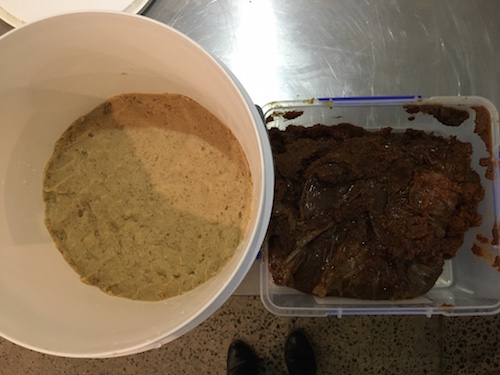Miso is a traditional Japanese seasoning produced by fermenting soybeans with salt and koji (the fungus Aspergillus oryzae) and sometimes rice, barley, or other ingredients. The result is a thick paste used for sauces and spreads, pickling vegetables or fish and meats, and mixing with dashi soup stock to serve as miso soup called misoshiru , a Japanese culinary staple.

Miso is High in protein and rich in vitamins ( B, E, K including B12 which most vegetarian diet lack ) minerals and folic acid. As a fermented food, miso provides the gut with beneficial bacteria that help us to stay healthy, vibrant and happy; good gut health is known to be linked to our overall mental and physical wellness.
The taste, aroma, texture, and appearance of miso all vary by region and season. In Japan, almost every prefecture would have their unique taste or their preference. There are hundreds of different types of miso and different versions are linked with regional cuisines, identities and flavours.
For example, Northern cold part of Japan would prefer reddish brown rice miso with a bitter salty taste whereas (AKAMISO) the southern part or west areas prefer whiter barley miso with a creamy mild sweet flavo ( SHIROMISO)
Other important variables that contribute to the flavor of a particular miso include temperature, duration of fermentation, salt content, variety of kōji, and fermenting vessel.
Miso’s unique properties and flavour profile can be attributed to the compounds produced through the fermentation process. Miso, depending on the variety, consists of a starter culture called koji, soybeans, and usually a grain (either rice, barley, or rye).The miso goes through a two step process; first creating the koji, and second the koji is combined with the other components and the mixture is left to be enzymatically digested, fermented and aged.
For many Japanese people, Miso is a comforting and staple food we love and can eat everyday.
It has also gained popularity amongst the western diet due to its nutritional benefit , an instant flavour foundation known as ‘umami’, to all sorts of dishes.
Winter is the perfect time to make a year worth supply of miso and I have been making my miso for the last 5 years. It is a very simple process !
So I decided to share the techniques and the goodness of miso, combining with a Japanese macrobiotic cooking demonstration workshop.
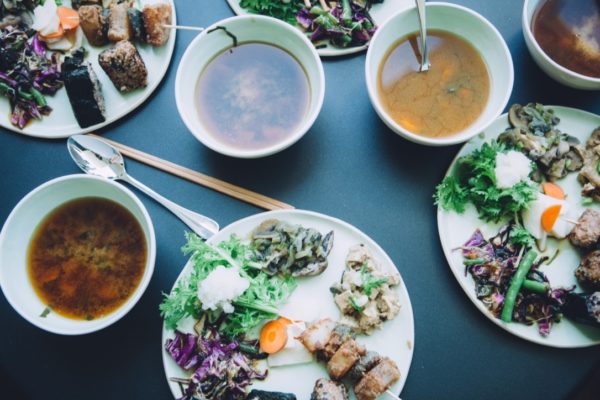
Basic miso recipe (makes 500g)
Special equipment needed: Fermentation vessel (pottery, enamel, glass or food grade plastic).
Ingredients:
220g soy beans (or other legume, i used 120 soy and 100g chickpeas)
220g koji (purchased them from a couple based in gold coast, Riceholic Tomo & Ayumi)
50 g sea salt

Steps:
1. Soak soybeans overnight before cooking.
2. Cook the beans until very soft. After cooking strain the soybeans and keep the water for later use.
3.Mash the cooked soybeans and place in a large mixing bowl. You can use a food processor to have a smooth paste but I would recommend using your hands and get into it !
4.Mix koji and salt.
5. Water left over from cooking the soybeans is now slowly added to the soybean/koji mixture to achieve a good consistency. The consistency is tested by forming the mixture into a ball and throwing it against a hard surface. If the ball cracks up or crumbles the mixture is too dry, if it splatters everywhere it is too wet. After achieving the correct consistency all of the mixture is rolled into balls.
5.The fermentation vessel should be cleaned with white alcohol or strong antiseptic herbal tea.
6.Throw the balls into the pot. The aim here is to remove any air pockets within the pot. When all the mixture is in the pot press to form a flat surface.
7. Sprinkled salt over the surface, especially around the edges as this is where uninvited moulds will first make their appearance.
8. Cover with cling film – again taking care to cover the surface right up to the edges – to help prevent moulds from forming.
9. Place a weight to compress and get the air out.
10. Store in a dark cool place out of sunlight for at least 3months.
11. Wait. The miso can be eaten after six months (if made during the warmer months) but it will be better if left for longer. Often it is left to ferment for one, two or even three years before consumption. As with most fermentation processes temperature is an important factor. Starting your miso in autumn it will likely need more than six months before consumption. During warmer times of the year the fermentation will be faster but so will the chances of competing moulds moving in. Check your fermentation vessel regularly and remove any moulds appearing on the surface. Even if a layer of mould covers the entire surface the miso below should be fine. Just scrape off the surface to a sufficient depth where only mould free miso can be seen.
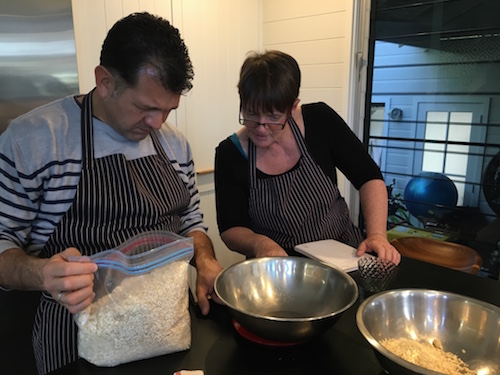
When I do my miso making workshops, I show people my 5yrs old miso ( the one on the left with a darker color ) which I made while I was still living in Japan and everyone is so surprised that it is still edible ! But it is the best medicinal paste I have !
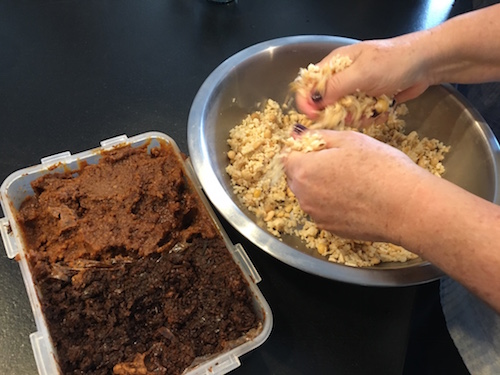
I made my 3kg first miso in Australia last year in May ( the one on the left in picture above, with a lighter brown color ) I wasn’t sure how my miso will turn out as the climate here is much warmer than compared to Japan and we don’t really have a harsh cold winter suitable for miso making ( and avoiding mould) but it has turned into this shiny brown dark rich miso which I have been enjoying very much.
During my cooking demonstration, I guide people through the core principles of macrobiotics which are
Ichibutstu Zentai – the way to eat the whole food, vegetable including the skin, leaves and root. This concept can be related to animal products where we consume the whole part of the animal, meat, bones, skins , game etc. Under the macrobiotic philosophy, some may argue that animal product should be not consumed at all but I believe it should not be a rigid diet , it is a lifestyle to practice conscious and responsible eating habits- as long as you eat wholesome and know where your food comes from, how it was processed etc.
Shindo Fuji– Eating locally and seasonally. Eating foods from your environment and that complement the seasons. For example, eating cooling fruits and vegetables during the summertime helps you to cool your body and become more balanced. Vice versa, eating more heating and heartier vegetables and animal products during the wintertime helps to heat your body.
Ying and Yang – The Yin/Yang principle comes from the Chinese philosophy that describes the order of phenomena as complementary opposites. Yin is more feminine based with core qualities like cool, intuition, emotion, expansive, sensitivity, dark, moon/night, etc. Yang is more masculine based with core qualities like hot, light, logic, strong, contractive, sun/day, etc. Each individual has both Yin and Yang qualities and they are not absolute, its just that one is usually more pronounced than the other. Disease and sickness arise when we are out of balance with our environment and our Yin/Yang constitution.

The macrobiotic diet is about discovering foods that help you achieve balance within yourself and your environment and to practice the art of self-healing.
I create my own recipe incorporating this philosophy using local and seasonal ingredients.
I go to the farmers market and look around. So what is available from Autumn and through winter?
Based on the metaphor of Five elements from Chinese Medicine, the organs associated with Autumn are the Lungs and the Large Intestine which reflect the spiritual nature of the season, letting go and receiving. The lungs and the large intestine, associated with metal in Chinese medicine, both deal with purification and elimination. The lungs take in oxygen and expel carbon dioxide through breathing. The large intestine absorbs water and completes the absorption of nutrients, minerals and vitamins. It also holds and eliminates waste.
Eating vegetables and whole grains is necessary for our bodies year-round. Because they serve as cleansers for the intestines, however, they have added significance in autumn, when it’s important to keep your metal element in balance. It is common for people to be more vulnerable to colds, bronchial infection and sinus issues in the cooler days of Autumn.
The color associated with Autumn is white and flavour is pungent. Daikon raddish, turnips , parsnips and any other root veggies are fantastic medicinal food .
Winter, the cold and dark season, is a time of inward reflection, rest and restoration. It is associated with water, the element of pooling, tranquility and flow. In the body, the water element is connected with circulation of the blood, perspiration, tears, the bladder and, most significantly, the kidney. In winter your body will appreciate warming foods like hearty soups, whole grains and roasted nuts, or steaming cups of ginger or cinnamon tea. To further fortify the kidney, eat black beans, kidney beans or red adzuki beans along with seaweed and steamed greens- the color associated is black . A simple way to feel more connected to the water element is to use sea salt instead of table salt on your food. A moderate amount of salty food can help nourish the kidneys, but remember that excessive salt damages them.
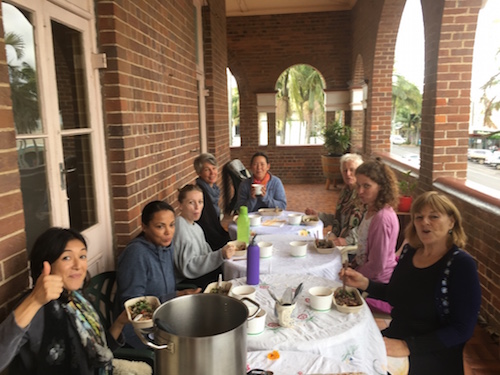
Here I made
Miso soup with Onion and Cabbage
Daikon raddish and Taro potato patties
Grilled eggplant with miso walnut butter
Mizuna, Raddish, Hijiki salad with Wasabi plum dressing
Black tahini pudding

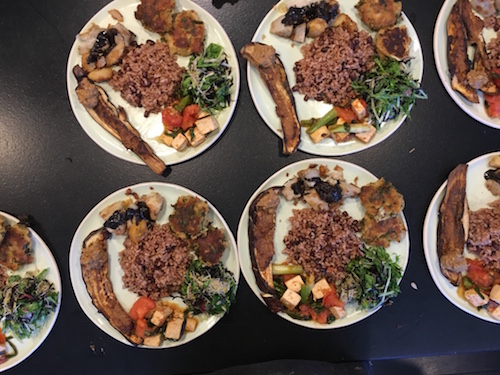

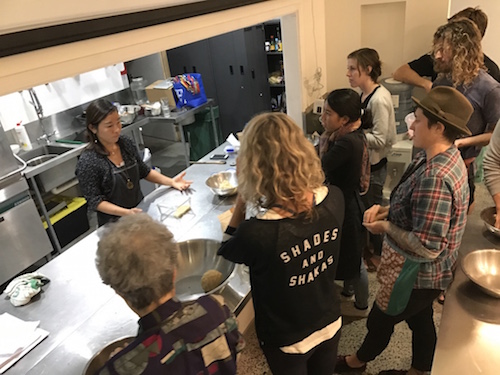
At my third workshop , I changed the menu slightly
Miso soup with Onion and Cabbage
Daikon raddish and Taro potato patties
Grilled eggplant with miso walnut butter
Mizuna, Raddish, Hijiki salad with Wasabi plum dressing
Grated Daikon and Carrot salad with mustard
Grilled sweet potato and turnips with cauliflower puree
Black tahini pudding


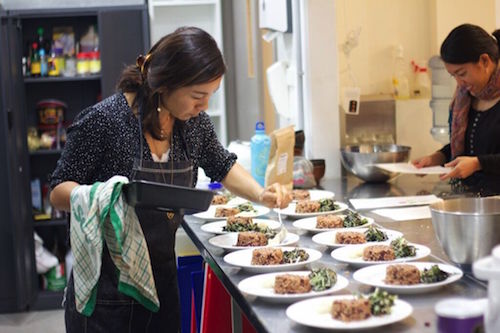

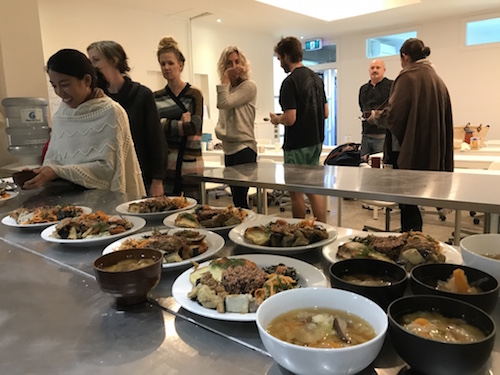

So this is the outcome of the workshop ( + full belly ! )
My new miso ( about 2kg ) on the left and my two other miso.
Hopefully my new miso will be ready in about 6 months !
